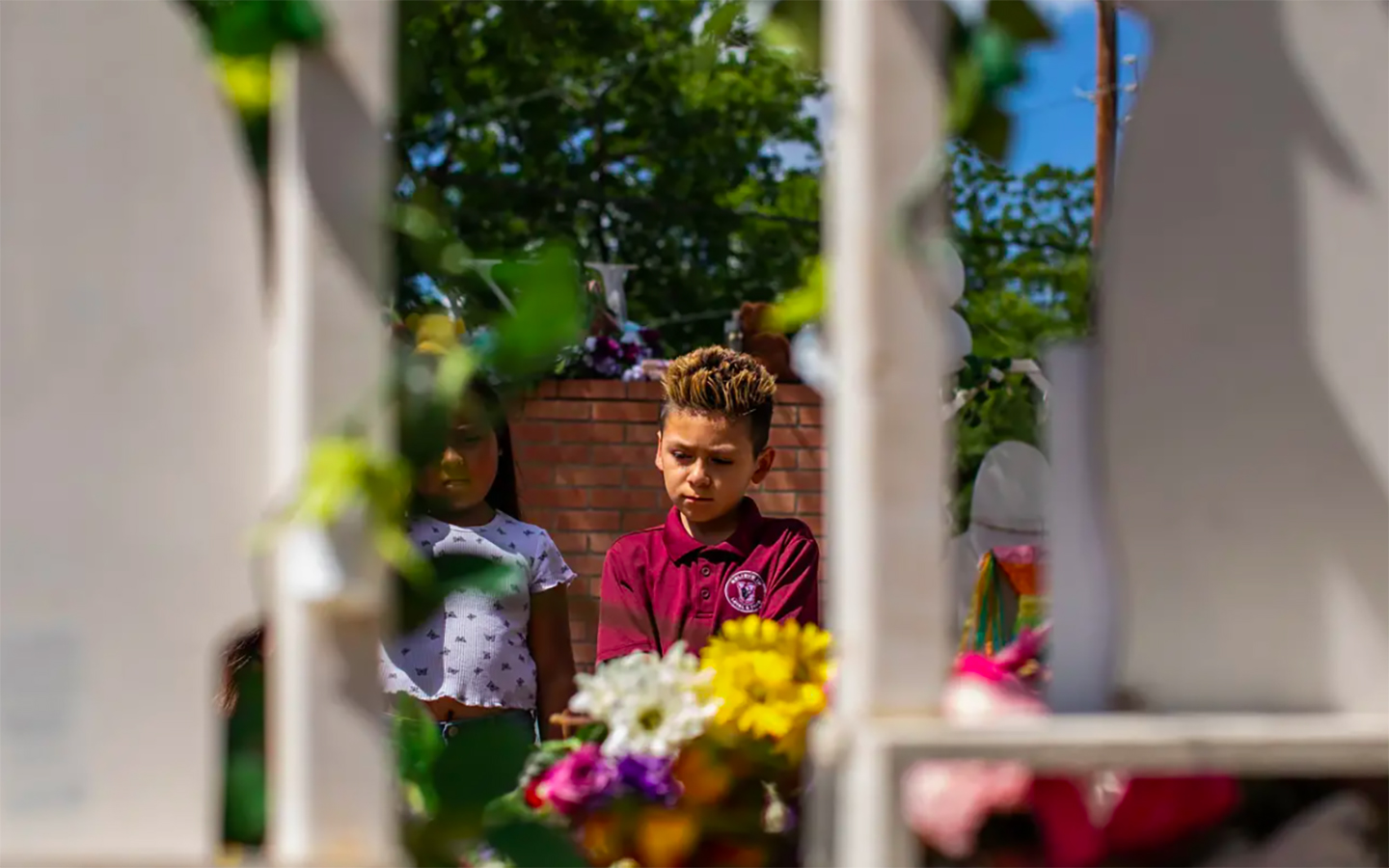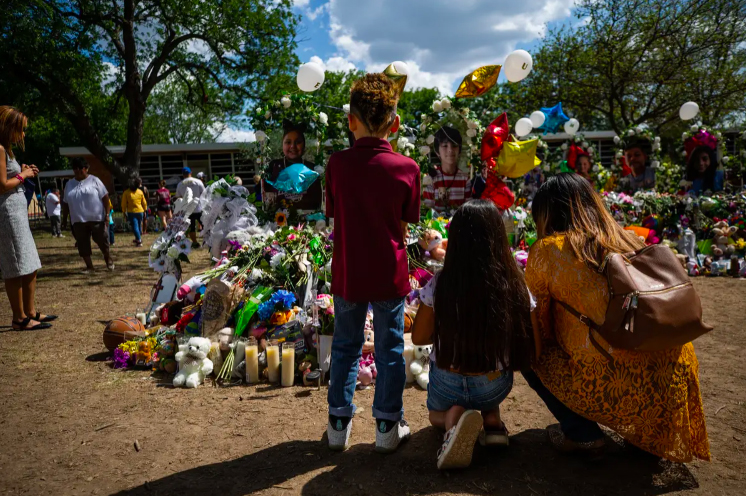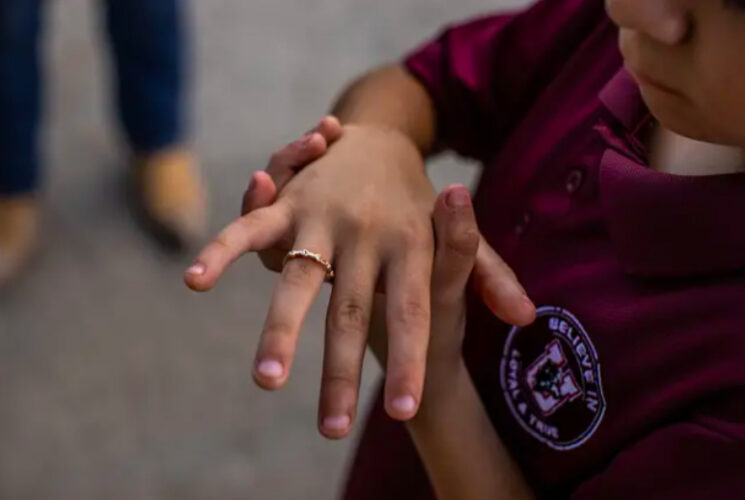For Kids Who Survived Uvalde Shooting Uninjured, Trauma Will Take Time to Heal
Uvalde offers mental health resources for the victims and considers rebuilding Robb Elementary as the community tends to its invisible wounds

For 24/7 mental health support in English or Spanish, call the Substance Abuse and Mental Health Services Administration’s free help line at 800-662-4357. You can also reach a trained crisis counselor through the National Suicide Prevention Lifeline by calling 800-273-8255 or texting 741741.
Eight days after surviving the shooting at Robb Elementary, 9-year-old Zayin Zuniga returned to the school grounds to visit the memorial for his slain classmates.
Zayin and his mom approached one of the 21 crosses that were set on the school’s lawn to honor each of the victims killed last week: the one for Eliahna Amyah Garcia, 9, whom Zayin called Ellie. After a school dance at Robb, Zayin decided he wanted to give Ellie a gift. He begged his mom to get him a ring that he could give her. He was never able to do it.
Zayin was in Room 111 during the shooting, one of the two conjoined classrooms where the gunman holed up. He recalls glass shattering and seeing bullet casings on the classroom floor as he and other students hid behind his teacher’s desk. Zayin and other kids were able to escape through a window.
“Everybody was scared,” he said.
Zayin often retreats to hug his mom as he recalls the scene. He can’t hear loud noises without thinking it’s the sound of another gunman trying to hurt people, said his mother, Mariah Zuniga.
The Zuniga family didn’t suffer any injuries or deaths that day, but invisible wounds linger in the form of trauma. Zayin doesn’t feel safe going back to Robb and isn’t ready to return to school in general. Research and studies suggest that child survivors will feel anxious after shootings, but talking to them about it and making them feel safe is needed to help them heal.
Research and experts also found that if there aren’t enough mental health resources for the survivors, witnesses and community, the trauma can impact education and lead to absences, declining grades and students choosing not to go to college.
Zayin and his family were at the Uvalde County Fairplex on Wednesday, an event center and indoor arena where organizations are offering counseling and mental health services to families and students affected by the shooting.
Zuniga said her son will need a professional therapist to talk to about the tragedy. When she first spoke to Zayin about his feelings after what happened last week, he burst into tears.
“I went to the counseling because I didn’t know what to really say to him after something like this,” she said.

Seeking ways to heal
Marcos Guzman, 12, who graduated from Robb Elementary last year, said he knew some of the kids and teachers who were killed last week. He doesn’t understand the senseless acts that left his peers dead, especially in Uvalde.
“I’m sad,” Guzman said in Spanish. “I just want to cry.”
As Uvalde grieves, local, state and federal officials are also looking for ways to help the community heal.
Texas Health and Human Services is overseeing the state’s crisis response in Uvalde, and therapists have been offering help in the immediate aftermath of the shooting. But services will also be needed for much longer to respond to its lasting emotional effects on both the surviving children and the families who are grieving, said Dr. Steven R. Pliszka, chair of psychiatry and behavioral sciences at UT Health San Antonio and program administrator.
“At some point, we’re going to need to transition from this acute response to working with people over the long term,” Pliszka said. “After the acute situation settles down, that’s usually when people find that they really need to return for help.”
A state-funded telehealth program for youth is offering services to the Uvalde Consolidated Independent School District to help identify students and families in mental or emotional crises and give them counseling or therapy services they may not otherwise have access to, Pliszka said.
The Texas Child Health Access Through Telemedicine program funnels resources and expertise into a network of doctors, counselors and other professionals at universities in 12 regions across the state to respond to children identified in schools as showing signs of distress.
“I have reached out to the superintendent, and if they wish to respond, we can certainly enroll them immediately. There’s no barrier whatsoever,” Pliszka said.
A network of mental health providers and experts from universities across the state have also volunteered their time through the state-funded Texas Child Mental Health Care Consortium, coordinating with Texas health officials to offer their services to adults and children in Uvalde, said Dr. Sarah Wakefield, chair of psychiatry at Texas Tech University Health Sciences Center in Lubbock and medical director of the university’s consortium-funded school-based mental health program.
That might mean giving a teletherapy session to a family who lost a loved one in the shooting, being available to run counseling sessions at the local civic center where the state is offering help for those who are grieving, or sending a social worker to a candlelight vigil to talk to people who are struggling with their emotions, she said.
In this first phase of trauma response, Wakefield said, those types of actions are key to keep grieving, frightened people connected to their community to get them through the devastating first few days after an extremely traumatic event.
“It’s really about helping people realize that even in the wake of tragedy, we’re not alone and there’s a community of support,” she said.
After the early shock gives way to longer-term grief, anger and helplessness, the people of Uvalde — and particularly the children at the school during the shooting — are at high risk of suffering from post-traumatic stress disorder, she said.
Characterized as having a prolonged sense of life-or-death alertness for a long period of time, PTSD can manifest in panic attacks and other emotional difficulties — as well as physical inflammation in the body that can lead to serious physical health problems like heart attack, stroke or cancer, Wakefield said.
“PTSD can occur when you experience a trauma in which you thought you might lose your life or a person very close to you might lose theirs,” she said. “Our biological systems are wired to keep us safe from trauma, to be on high alert, to be able to run or to fight if we need to do that. But when we’ve been exposed to extreme trauma, many of our brains — 20-30% typically — will kind of stay in that high-alert place. … You will have this prolonged biological response as if that trauma is happening over and over and over.”
The younger the victim is and the closer they were to the event, the more likely they are to suffer from PTSD afterward, she said.
An extremely traumatic event can also trigger underlying or undiagnosed psychological problems in people, maybe even for the first time, such as major depression or anxiety, schizophrenia or bipolar disorder, she said.
“Maybe there was a predisposition to things that you hadn’t manifested yet, but this is a major trigger … to further illness,” she said. “And so we could see new onset of other types of illnesses that were triggered by all of the emotionality and the helplessness and hopelessness of this tragedy.”
The shooting may also worsen symptoms in those already suffering from mental health issues, as well as the prolonged and complex grief from the sheer loss of life that will affect some people’s ability to function well in the future if they don’t have access to some help, Wakefield said.
And while the risk of mental toll is highest for those children and adults who were in the school when the shooting happened, the lingering trauma is likely to permeate throughout the tiny rural town of 15,000, Wakefield said.
“I grew up in a town around that size, and I can imagine the impact on them,” she said. “It will affect the whole town.”
“That building needs to be gone”
Some officials have suggested that Robb Elementary should not be a reminder of the shooting and proposed that the school be torn down and replaced with a new building.
State Sen. Roland Gutierrez, D-San Antonio, told San Antonio television station KSAT there is hope that the federal government will provide a grant to rebuild the school. He said President Joe Biden, who visited Uvalde on Sunday, told him, “We’re going to look to raze that school and build a new one.”
“I can’t tell you how many little children that I’ve talked to that don’t want to go back into that building. They’re just traumatized. They’re just destroyed,” Gutierrez told KSAT.
Uvalde Mayor Don McLaughlin said he believes the same should be done.
“I don’t think anybody’s plans are but to tear that building down,” McLaughlin told KXAS-TV. “I would never ask, expect a child to ever have to walk in those doors ever, ever again. That building needs to be gone.”
The school district’s superintendent announced Wednesday that students and teachers won’t return to Robb in the fall and instead will relocate to other campuses.
Generations of Uvalde residents have gone to Robb Elementary, which has served the community since 1955 and has been the site of momentous progress for the mostly Latino town of about 15,000. In the 1970s, Mexican American families staged a walkout to make the school more inclusive.
The school holds sentimental value for many of the city’s residents, but that shouldn’t stop officials from demolishing and building a new school, said Uvalde resident Dolores Contreras, 77.
Contreras said she went to Robb as a child, along with some of her siblings. Her children and grandchildren attended the school, too. But now, helping the community heal should be the priority.
“It should come down,” she said. “Kids don’t feel safe.”
Other schools across the country have been demolished after mass shootings. Santa Fe High School near Houston; Marjory Stoneman Douglas High School in Parkland, Florida; and Sandy Hook Elementary in Newtown, Connecticut, have either renovated or built new buildings with features like bullet-resistant walls and windows.
Zayin and his mother don’t want to go back to Robb, either. Zuniga, who moved to Uvalde a year ago, said they have a lot to think about before deciding where Zayin will continue his education.
“None of my kids want to go back,” she said. “It’s just so scary to think about something like this happening again.”

Fears that won’t vanish easily
The road to recovery will be long for students who survived the shooting and for their parents.
Zuniga said it will be hard to forget the fear she felt when she first learned there was an active shooter at her children’s school. She couldn’t grasp what was happening. She was in San Antonio when she first got a text about the incident and raced to make the nearly 80-mile drive back to the school.
Zuniga has another child that goes to Robb. She was in the cafeteria and was able to get to a safe house quickly. She didn’t know that Zayin had been in one of the classrooms the gunman attacked until they had reunited.
“Being able to see them again, it’s like you’re so thankful and grateful,” she said. “And you don’t want to take that for granted because there’s other families that don’t get to see their kids anymore.”
Wherever her children go to school next, Zuniga said she will meticulously look through its safety protocols. The family might move somewhere else. She’s even considering home schooling. All the options are on the table.
“I don’t know if we’re gonna end up relocating. We just moved here,” she said.
For the first couple of nights after the shooting, Zayin stayed with his mom in her bedroom. They really couldn’t sleep. The events would still play over in his head, she said. They would take melatonin to try to get some rest.
The two of them visited the memorial at Robb on Wednesday to start the healing process. Zuniga finally got Zayin the ring he wanted to give to Ellie and placed it on her memorial.
He now wears a matching one to always remember her.
Disclosure: Texas Tech University and Texas Tech University Health Sciences Center have been financial supporters of The Texas Tribune, a nonprofit, nonpartisan news organization that is funded in part by donations from members, foundations and corporate sponsors. Financial supporters play no role in the Tribune’s journalism. Find a complete list of them here.
This article originally appeared in The Texas Tribune at https://www.texastribune.org/2022/06/03/uvalde-texas-shooting-survivors-trauma/.
The Texas Tribune is a member-supported, nonpartisan newsroom informing and engaging Texans on state politics and policy. Learn more at texastribune.org.
Get stories like these delivered straight to your inbox. Sign up for The 74 Newsletter

;)
